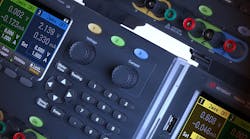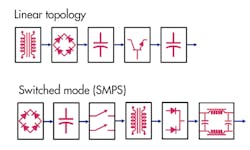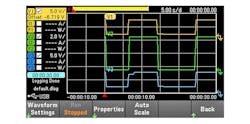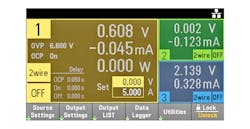Download this article in PDF format.
Bench power supplies come in all shapes and sizes. Some fall into the general-purpose category, and others are very application-specific. Some only have a single output, while others offer multiple outputs.
Because today’s designs place higher demands on the systems that power them, newer-generation bench power supplies are packed with very useful features that help engineers address those problems much earlier in the design process. This includes controlling multiple power-supply voltage sequences, measuring wide dynamic ranges of current, and varying the speed of the power-supply voltage to reflect real circuit characteristics.
Underlying all of this, bench power supplies need to be easy to use, deliver clean and stable dc power, and protect themselves and the development board (or DUT). It’s not uncommon for bench power supplies to also be used in automated systems, so modern I/O connectivity might be another important consideration.
This article delves into problems that the new generation of power supplies (Fig. 1) can uniquely solve, and factors to consider when specifying or purchasing a power supply.
1. Keysight’s E36300 Series triple-output dc power supplies represent the "new" generation.
Design Topology: Linear vs. Switcher
A fundamental requirement of a power supply is an output signal with a high level of signal integrity, especially when working on a delicate design. The design topology of a power supply can tell you a lot about its signal integrity.
Generally, dc power supplies are developed with either linear or switch-mode technology, each offering different advantages. Linear power supplies tend to have low output noise, fast transient response, and high programming speed. However, they also come with a series of disadvantages, such as low efficiency, more cooling, higher level of low-frequency magnetic radiation, and (usually) larger-sized.
Switch-mode power supplies are typically smaller in size, provide higher efficiency, and require less cooling. Some of the disadvantages include slower transient response and higher output noise. However, design advances are enabling the newer generation of switch-mode power supplies to perform just as well as linear power supplies in those areas.
2. This simplified block diagram compares the design topology between linear and switching power supplies.
Newer bench power supplies provide the best of both topologies. To achieve higher power in a smaller package, Keysight combined a linear output stage with a phase-controlled pre-regulator. Some of the benefits of this approach are better efficiency, double the output power, and lower acoustic fan noise (Fig. 2).
High- and Low-Current Measurements
More and more applications require low current measurements such as idle/standby current on devices while in a low-current consumption state. These measurements can only be made with a power supply that accurately measures low-current values. Newer power supplies can measure dc current in the 100-µA range. However, be sure to check the datasheet for accuracy of measurement specifications at that range.
There may also be situations when more current is needed than can be provided by an older dc bench power supply. Newer bench supplies come with a built-in auto-parallel-mode capability that allows the engineer to combine two channels into a single, higher-current dc output channel rated as high as 25 V and 4 A. This eliminates the need to find and add another power supply into the test design. In a way, new bench power supplies with auto-parallel capability perform the work of two power supplies.
Advanced Capabilities
Modern bench power designs fully take advantage of the latest graphical displays, microprocessors, and FPGAs. Thus, many advanced capabilities are built-into newer power supplies to save you time and money.
3. In Data Logger view, you can log data on multiple traces. Here, the voltage of output 1, output 2, and output 3 are captured over 30 seconds.
One example is the ability to synchronize multiple outputs on a power supply. Without this feature, a design engineer could spend hours writing code to perform this synchronization. Another example is the ability to create a dynamic user-defined output signal on a power supply to eliminate the need of a second setup requiring additional programming and instrumentation (Fig. 3). With these and other advanced features, you will use less test equipment, set up tests faster and more simply, and reduce test setup errors—all of which save time and money.
Protection and Safety Features
When dealing with power, protection and safety come first. When a device fails, or goes up in smoke, it may be catastrophic. It’s not only important for the power supply to protect itself, but also protect the device under test (DUT) and the operator. When a DUT fault occurs, protection circuits in the power supply can limit the voltage, limit the current, and shut off all outputs with a single button push.
For example, the E36300 Series from Keysight integrates overvoltage, overcurrent, and over-temperature protection to prevent damage to the DUT. One push of a button on the front panel can shut down all power-supply outputs.
Enhanced User Experience
An intuitive user interface that allows you to easily navigate, control, and track each channel is another important feature with the latest power supplies. Equally important is a large graphical display that lets you see all of the output channels at the same time. With newer power supplies, you can set up advanced capabilities like remote sense, auto-parallel/auto-series, tracking mode, voltage sequencing, voltage steps, and data logging of V/I pairs over time with one push of a button.
In addition, modern I/O control such as built-in USB and LAN is typically available in modern power supplies. Support software can simplify automated measurement setup, recording, and analysis.
4. The user can view details of a single channel, including the measured power, OVP/OCP condition, and delays.
It’s convenient to be able to see all channel readings and settings on the same screen (Fig. 4). This may not be obvious, since many of the older power supplies make the user toggle back and forth to compare the channel setting and the reading. Newer power supplies make this information available on the same screen.
Performance Characteristics
Unfortunately, no standards have been established for power-supply datasheet specifications. Descriptions of the specification, as well as the specifications themselves, are determined by the manufacturer and will vary from one manufacturer to another. It’s also at the manufacturer’s discretion whether a characteristic is even specified. Some vendors specify more than others. Texas Instruments’ experts wrote an application note, titled How to Read Your Power Supply’s Data Sheet, to help you better understand power-supply datasheets and evaluate which power supply best meets your needs.
Total Cost of Ownership
The cost of an instrument includes the initial purchase price, as well as ongoing maintenance expenses plus the opportunity cost of downtime for calibration and repairs. Look for a manufacturer that will provide worldwide maintenance and support, a dedicated support team, and a solid track record for delivering products that last for 20 years or more.
For more information, visit Keysight's site, or check out the application note “Seven Ways to Speed Up Your Testing with a Modern DC Bench Power Supply.”





